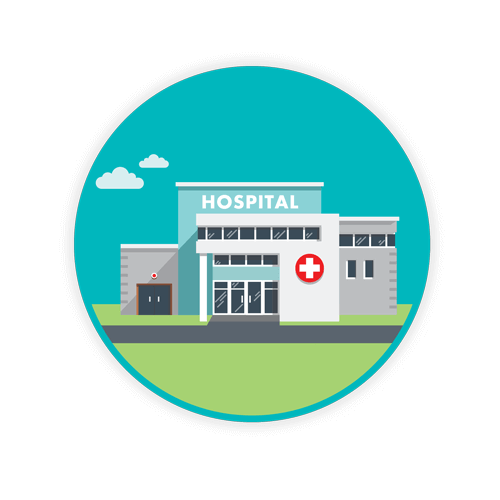Checklist for Hospital Waste Management

Has your hospital facility, veterinary clinic, dialysis center, or outpatient center devised a checklist for hospital waste management? Even if you’re not a hospital, it’s recommended that you adhere to the highest applicable standards for overall healthcare waste management.
Hospital waste is defined as any type of waste that’s generated during the diagnosis, treatment, or immunization of human beings or animals or in any type of research in a hospital environment. Much of this waste contains a high potential for either injury or infection. Therefore, it is the responsibility of hospitals to ensure safety to people and environment through proper waste management.
Laws and regulations for hospital waste segregation and medical waste disposal differs from state to state, but federal regulations must always be followed. Fines and penalties for non-compliance can cost tens of thousands of dollars every day for violations.
Areas to cover in a hospital waste checklist
When it comes to creating a checklist or updating one for hospital waste management, a number of areas should be considered. For example, Ohio created a hospital waste management checklist (updated frequently) that covers environmental compliance as well as pollution prevention tools. For example, some of the topics that can be included in a hospital waste management checklist include but are not limited to:
Compliance. For example, are you compliant with federal and state regulatory agencies when it comes to healthcare waste segregation protocols applicable to your facility size or type of waste generated there? What about your medical waste removal services? Be aware of federal and state laws. For example, are you following regulations from federal agencies or legislation, such as covered in the:
- Resource Conservation and Recovery Act – has your healthcare facility identified hazardous waste streams defined by this act? (40 CFR 261, 262, 265)
- Clean Air Act
- Clean Water Act
Definitions. Your checklist for hospital waste management should include topics such as these (the first two proposed by New York State):
- Waste segregation – doing so also gives any medical waste generator a good estimate of the monthly quantity or volume of regulated medical waste amassed at their facility. It also aids in the determination of the types of medical waste generated at the facility and ensures that employees at all levels at the hospital facility know how to segregate various waste streams.
- Containment, storage, and transportation issues, which must adhere to federal and state guidelines. Often, state legislation is more detailed than the federal.
- Container or bin placement and positioning that drives safe disposal methodologies in every department of a hospital
- Waste Movement and Waste flow that ensures minimimum interruption to patient care, eliminates cross-contamination risks, and drives labor efficiencies
- Waste Audits - the routine auditing of medical waste bins or hazardous waste containers to ensure correct segregation protocols are being met
- Hazardous Waste accumulation checks to ensure that your generator status is being correctly assigned and the correct storage requirements are being met
A checklist for hospital waste management should also consider your generator status, such as small quantity generator, a large quantity generator, or a very small or conditionally exempt small quantity generator? Are you aware of the differences between them?
- Small quantity generator (SQG) – generates more than 220 pounds per month, but less than 2200 pounds per month of hazardous waste.
- A large quantity generator (LQG) generates more than 2200 pounds per month, but may also accumulate more than that amount at any one time or 2.2 pounds or more of acutely hazardous waste.
- A conditionally exempt small quantity generator (CESQG) typically generates less than 220 pounds per month and will never accumulate more than 2200 pounds or 1 kg of acute hazardous waste on a monthly basis.
 State Guidelines for Hospital Waste
State Guidelines for Hospital Waste
Not all states provide the same guidelines. For example, in California, the California Department of Public Health provides a medical waste program that provides information on how to dispose of controlled substances, the difference between generators, and laws, regulations, and standards that are applicable to California’s Medical Waste Management Act.
Your hospital waste management checklist should also contain an affirmative, negative, or “somewhere in between” notation in regard to hazardous waste management training for employees, as well as a hazardous waste contingency plan, especially for large quantity generators. In addition, such a plan or checklist should also include whether the facility is taking steps to reduce and potentially eliminate volume of chemicals or other toxic materials when possible.
Employees should also be trained in the handling of infectious and solid wastes, as it’s important that infectious waste be separated from non-infectious waste at its point of generation. What about sharps and sharps container usage? Are sharps infectious waste appropriately disposed of in appropriate containers? What about unused or non-infectious discarded hypodermic needles?
When it comes to infectious waste or “red bag waste” or other regulated medical wastes, are they labeled with the words ‘Biohazard’, and is the integrity of the packaging of such wastes up to standards of federal and state guidelines?
Other things to consider include spill prevention controls and guidelines for choosing not only medical sharps disposal companies, but medical waste disposal options and medical waste pickup companies.
Note: Medical waste generators are the ultimate facility responsible for the proper disposal of medical waste, even after that waste has left the facility. Daniels Health emphasizes the cradle-to-grave approach when it comes to healthcare waste management. This is applicable to numerous waste streams such as anatomical waste, biohazard waste disposal, and waste segregation.
Importance of hospital waste management checklists
Regardless of size or whether you treat humans or animals, the importance of a checklist for hospital waste management is not to be underestimated.
Not only does such a checklist ensure that you are compliant with federal and state guidelines, but it's flow on environmental benefits are considerable; with dedicated focus on waste segregation and the correct identification of medical vs non-medical waste; a checklist executed effectively has the potential to reduce the volume of medical waste that ends up in landfills.
It is the medical waste generator’s responsibility to protect public health as well as the environment. With 30+ years experience partnering with some of the most prominent hospital brands in the United States including Advent Health, Stanford, Advocate Aurora, Henry Ford Health System and Rush University, Daniels Health are the clinically-focused experts when it comes to healthcare waste management. We provide effective, efficient, and sustainable solutions for medical waste and hospital waste management at scale and facility-based customization. We get asked often "how do you reduce waste in hospitals", and while there's a few core principles applicable to all hospitals, each facility is different and it's essential that clinical and EVS staff are involved in the process. For information of how we can help you not only reduce the volume of medical waste you produce at your hospital, but also save money while you’re doing it, call us today.
OUR HOSPITAL APPROACH REQUEST A CONSULTATION
